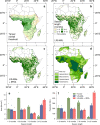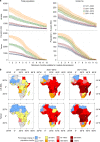Incorporating hydrology into climate suitability models changes projections of malaria transmission in Africa
- PMID: 32859908
- PMCID: PMC7455692
- DOI: 10.1038/s41467-020-18239-5
Incorporating hydrology into climate suitability models changes projections of malaria transmission in Africa
Abstract
Continental-scale models of malaria climate suitability typically couple well-established temperature-response models with basic estimates of vector habitat availability using rainfall as a proxy. Here we show that across continental Africa, the estimated geographic range of climatic suitability for malaria transmission is more sensitive to the precipitation threshold than the thermal response curve applied. To address this problem we use downscaled daily climate predictions from seven GCMs to run a continental-scale hydrological model for a process-based representation of mosquito breeding habitat availability. A more complex pattern of malaria suitability emerges as water is routed through drainage networks and river corridors serve as year-round transmission foci. The estimated hydro-climatically suitable area for stable malaria transmission is smaller than previous models suggest and shows only a very small increase in state-of-the-art future climate scenarios. However, bigger geographical shifts are observed than with most rainfall threshold models and the pattern of that shift is very different when using a hydrological model to estimate surface water availability for vector breeding.
Conflict of interest statement
The authors declare no competing interests.
Figures




Similar articles
-
Future malaria environmental suitability in Africa is sensitive to hydrology.Science. 2024 May 10;384(6696):697-703. doi: 10.1126/science.adk8755. Epub 2024 May 9. Science. 2024. PMID: 38723080
-
Shifting transmission risk for malaria in Africa with climate change: a framework for planning and intervention.Malar J. 2020 May 1;19(1):170. doi: 10.1186/s12936-020-03224-6. Malar J. 2020. PMID: 32357890 Free PMC article.
-
Leveraging big data for public health: Mapping malaria vector suitability in Malawi with Google Earth Engine.PLoS One. 2020 Aug 4;15(8):e0235697. doi: 10.1371/journal.pone.0235697. eCollection 2020. PLoS One. 2020. PMID: 32750051 Free PMC article.
-
New directions for malaria vector control using geography and geospatial analysis.Adv Parasitol. 2024;125:1-52. doi: 10.1016/bs.apar.2024.06.001. Epub 2024 Jun 26. Adv Parasitol. 2024. PMID: 39095110 Review.
-
Climate change could shift disease burden from malaria to arboviruses in Africa.Lancet Planet Health. 2020 Sep;4(9):e416-e423. doi: 10.1016/S2542-5196(20)30178-9. Lancet Planet Health. 2020. PMID: 32918887 Free PMC article. Review.
Cited by
-
Modelling the spatial risk of malaria through probability distribution of Anopheles maculipennis s.l. and imported cases.Emerg Microbes Infect. 2024 Dec;13(1):2343911. doi: 10.1080/22221751.2024.2343911. Epub 2024 May 2. Emerg Microbes Infect. 2024. PMID: 38618930 Free PMC article.
-
Investigating the Impact of Irrigation on Malaria Vector Larval Habitats and Transmission Using a Hydrology-Based Model.Geohealth. 2023 Dec 10;7(12):e2023GH000868. doi: 10.1029/2023GH000868. eCollection 2023 Dec. Geohealth. 2023. PMID: 38089068 Free PMC article.
-
Water Resources in Africa under Global Change: Monitoring Surface Waters from Space.Surv Geophys. 2023;44(1):43-93. doi: 10.1007/s10712-022-09700-9. Epub 2022 Apr 20. Surv Geophys. 2023. PMID: 35462853 Free PMC article. Review.
-
Satellite Observations and Malaria: New Opportunities for Research and Applications.Trends Parasitol. 2021 Jun;37(6):525-537. doi: 10.1016/j.pt.2021.03.003. Epub 2021 Mar 25. Trends Parasitol. 2021. PMID: 33775559 Free PMC article. Review.
-
Asymptomatic malaria and nurturing factors in lowlands of Ethiopia: A community based cross-sectional study.PLOS Glob Public Health. 2022 Aug 16;2(8):e0000659. doi: 10.1371/journal.pgph.0000659. eCollection 2022. PLOS Glob Public Health. 2022. PMID: 36962734 Free PMC article.
References
-
- World Health Organisation. World Malaria Report 2018 (World Health Organization, Geneva, 2018).
-
- Jepson WF, Moutia A, Courtois C. The malaria problem in Mauritius: the binomics of Mauritian anophelines. Bull. Entomol. Res. 1947;38:177–208. - PubMed
Publication types
MeSH terms
LinkOut - more resources
Full Text Sources
Medical

